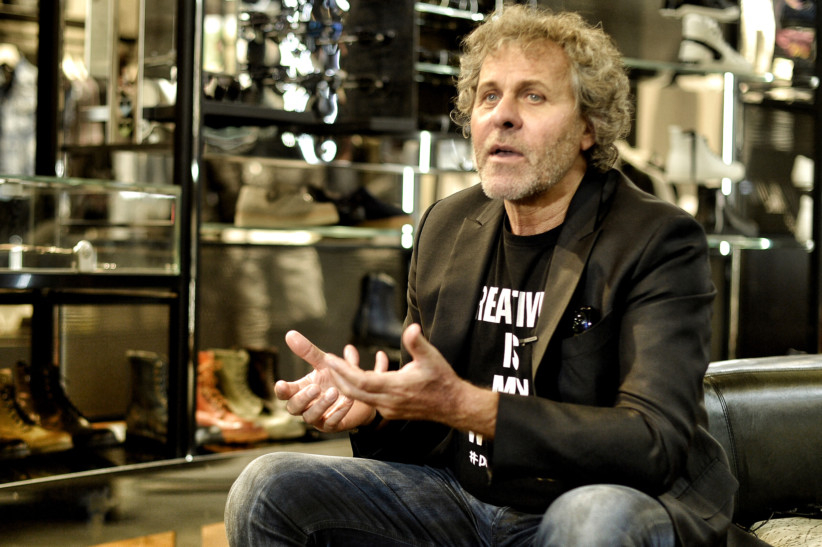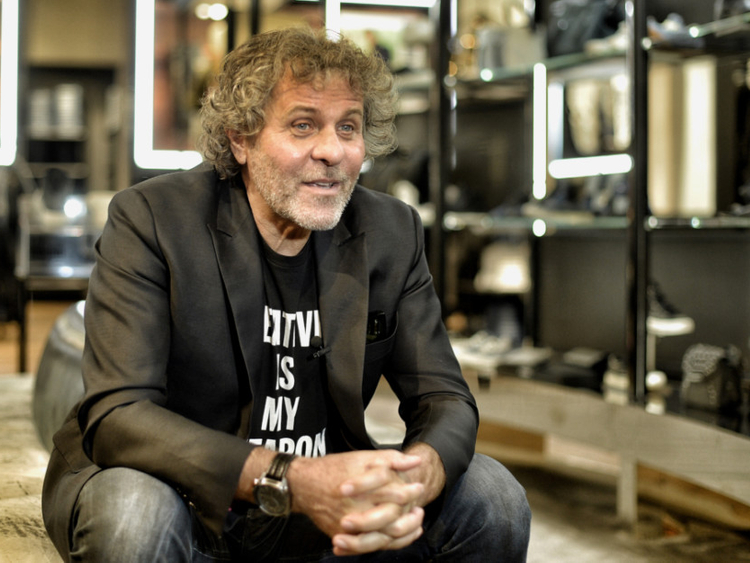
As we wait, camera ready, for Renzo Rosso at the Diesel store in The Dubai Mall, I decide to wander around the shop hoping to get some clarity as to how a regular denim brand has managed to become one of the most glamorous fashion brands in the world.
Rosso is the founder of OTB — the holding group of Diesel and three other fashion brands: French coutourists Maison Margiela, Dutch designers Viktor & Rolf and the Italy-based Marni. While Marni was his most recent acquisition, Viktor & Rolf and Maison Margiela were bought out by him in the last 10 years.
It’s noon and in walks the Denim Dio (Denim God) as he is popularly known in the fashion industry, followed closely by what could just about qualify as an entourage. His hair’s a curly blonde mess, his jeans faded and his T-shirt emblazoned with the words “Creativity is my weapon”. He fits the role of a denim-wearing rebel perfectly.
Following a firm handshake and a broad smile, we set the cameras rolling. As he begins to answer my first question seated on a bench in the middle of the store, his piercing blue eyes offer a glimpse of the brilliant PR magician that lurks within.
Rosso debuted this year on Forbes’ list of the world’s top billionaires and is, according to the magazine, worth $3 billion (Dh11 billion). Growing up on a farm, his is the typical rags-to-riches story where intuition, hard work and unmatched ambition have turned a nondescript denim brand into a multi-billion dollar company.
But how did this brand-maker keep his denim flag flying so high?
“I was 12 years old when I got my first pair of jeans,” says Rosso as he breaks out into a reminiscent smile, “I loved them and since then every single day of my life I have worn denim. Jeans are everything. It’s how to be free; it’s how to be a rebel; it’s comfort; it’s a blue sky and a green garden. This is why jeans have become such a big part of me and are now part of every single person.”
Diesel reportedly sells about 15,000 pairs of jeans daily across the globe – a figure that Rosso says comes as a pleasant surprise to him.
“I never think about numbers in that way. That’s unbelievable! I am so happy that we’re still doing so well globally. The quality is still the same, but what we do a little differently now, is we raise the status of the brand and we’ve started to do some higher quality products.”
Middle East is important to us
Diesel Black Gold is what he’s alluding to. Even though the sub-brand was launched in 2008, it’s pushing hard in the Gulf to find its spot. The brand builds on Diesel’s casual nature by using refined fabrics, detailed stitches and special treatments to give the finished product a vintage feel.
And with spending power in this particular region being better than most places in the world, it’s no surprise that Rosso feels this is an important market.
“Today every market is important,” he says. “But when you are here and you see the reality of Dubai, it becomes even more important. Dubai today is so global and international. Every brand sells here. A lot of our business comes from this country, so we need to be here.”
“I just came from Riyadh and Jeddah,” reveals Rosso, “I even went to Bahrain and it was unbelievable; [They were] a little bit different in mentality. Dubai, of course is more avant garde, because it’s more international, but [Riyadh and Jeddah] were a very big surprise, a very positive surprise. This country [UAE] is going to become more and more important to us in the future.”
Known for its sometimes controversial campaigns, Diesel’s aggressive marketing strategy has not faced problems with the reasonably conservative GCC market, he says.
“It is part of my attitude to do things differently. [Diesel] is not so rebellious; it likes to do what the new generation wants and [therefore] how to relate to them,” he says. “This is what the Diesel brand has done all over the world from the very beginning. And we have come here with this same global mentality; even if some areas are very conservative, we will do things that will bring us close to the new generation here.
“The new generation is becoming more and more similar all over the world,” he adds. “Now through the internet, we are connected to everything; they know what is going on everywhere. Even if governments try to drive the population a different way, the new generation knows everything. The more we grow, the more the new generation will take up leadership and drive us into a better world.”
The Dalai Lama inspired the OTB Foundation
Rosso, who is very keen on charity and uplifting the less fortunate, says he is very proud of what the OTB Foundation stands for and has achieved so far. He says he prefers helping without showing it, but he changed his way of doing things only after meeting the Dalai Lama.
“When I met the Dalai Lama, he said to me, ‘you have to do charity and you have to use your name because the more you do, the more visibility you give to it and more people will follow you.’”
This inspired him to set up the OTB Foundation.
“We always keep some money from [all] our companies and we help people to have a better way of life in the world. There are so many people who need help in this world. So we spend 15 per cent of our money on Italy and the rest mostly in Africa. “
Hiring John Galliano was not a strategy
While his favourite designers include Viktor Horsting and Rolf Snoeren, behind the Victor & Rolf label; and Dean and Dan Caten of DSquared2, John Galliano seems to be his trophy despite the controversy that came with him.
Galliano was famously fired in 2011 as creative director of the hallowed fashion house Christian Dior after a video of him making anti-semitic comments leaked on the internet.
“When Martin Margiela left the company we stayed five years without anyone and at the end [we decided that we would] only hire someone who could do the whole role from beginning to end,” Rosso explains. “Martin was revolutionary; even today if you look at the top luxury brands, like Balenciaga for example, they take the mood of the old Margiela. Martin was an exceptional man, who inspired so many brands.
“Even Martin loved the idea and told me it was the best I could have done. [Galliano] is not only a designer, he is a couturier. Of course, it was a [difficult] time when John joined us and he was coming out of a bad story, but everyone makes mistakes in their life and I love to give equal opportunities to everyone.”
As noble as it may sound, it does seem to be a fantastically strategic move. But Rosso denies it. “I didn’t do it for that; I really only chose John because he is a god in the design world. You have to see him when he’s working and doing fittings. He spends hours and hours on millimetres just trying to fit it perfectly to the body… it’s unbelievable.”
Nicola Formechetti is Renzo Rosso
Rosso’s blue-eyed boy, the Japanese-Italian Nicola Formichetti, who used to style Lady Gaga, seems to have a bright future at Diesel, going by what Rosso has to say.
“I followed Nicola for about two years before I hired him,” admits Rosso. “I needed someone to replace me. While I am the founder of Diesel, I had to take on a bigger role so I needed somebody to take the creative direction. [Formichetti] is the younger version of me. He is crazy and a visionary; he’s perfect to run Diesel for the next however many years.”















